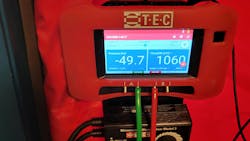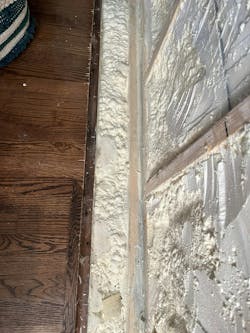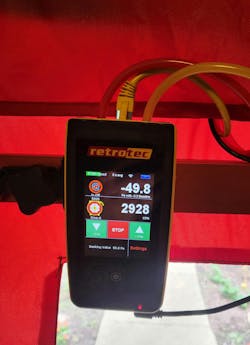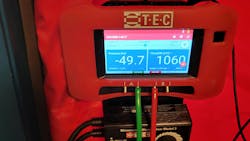Summer is winding down, and the heating season is fast approaching. Tis the season for apple cider, sweaters, and football. That means Halloween is right around the corner. The neighborhood children will expect to see my house decorated with dark festive items such as giant spiders and a witch standing before her cauldron, creating evil potions.
That means it’s time for me to climb up in the attic and pull down the box of decorations. Unfortunately, that means I may encounter spooky things like mice and giant spiders in my attic that also have a way of making it into the living space and creating a house of horrors for my family. You see, for many years, I was lucky enough to let my house decorate itself. The scary things came inside all on their own. When you live in an old, leaky home, it’s easier for them to come inside than you may think. Here’s how I used building science to figure out how my home was becoming a house of horrors.
My House as A Test Case
Several years ago, I decided to dip my toe into building science. In all reality, it was more like diving into a pool with my clothes on without first testing the water. I saw the importance early on and almost immediately purchased a blower door. I thought if I could diagnose a leaky house, it would help me be more precise when sizing HVAC equipment. While testing, I started seeing how building leakage drastically impacted energy use and comfort. Patterns emerged as I used measured building leakage in my load calculations.
I used my home for a test case. It was built in 1961 and is in the western suburbs of Chicago. It is a 1,900-sq. ft. ranch with a full basement. A blower door is a frame covered with a vinyl material and has a fan mounted in the middle.
I set it up in the front door of my home and closed all of the exterior doors and windows. The goal is the run the fan and create either a negative or positive differential pressure of 50 pascals in between the house and outside. Once you hit 50 pascals of differential pressure, you look at how many cubic feet per minute is moving through the fan. That number is the CFM50 and had measured leakage of over 3,000 CFM50, which is not good for its size.
Our subdivision is like a rural bubble in an otherwise urban area, surrounded by countless trees on the property. Living with nature means we must also deal with bugs, spiders, and mice constantly trying to invade our home in search of a warm shelter during the cold winter months.
There were two key features that were left out of the real estate listing when we bought our home. The first was the mice that would constantly find their way into the kitchen cabinets throughout the fall and winter. The second was the spiders that would create intricate webs strewn about the rim joist of our unfinished basement. It would be an understatement to say that these unwanted guests have caused added stress to my home life. My family would dread doing laundry in the spooky basement and be horrified if a mouse came into contact with the plates or silverware in our kitchen.
The Work Begins
Two years ago, I decided to start air-sealing my basement. I purchased a few froth packs, which is the homeowner's DIY version of closed-cell spray foam. I went to work insulating the rim joist. The rim joist is a 2x8 that sits upright on top of a bottom plate that wraps around the perimeter of the home. I sealed the rim joist to the floor joist and then sealed the rim and floor joist to the bottom plate.
Another leakage point was the gap between the bottom plate and the concrete foundation. This assembly was the source of most of my basement leakage. I could not seal the north wall because the last floor joist was running parallel to the foundation and was so close I couldn’t fit my hand or spray foam gun into the cavity, but more on that later.
I noticed that we didn't have cobwebs after air-sealing the basement. The space was suddenly much less spooky. My first round of air sealing didn’t solve the rodent issue in the kitchen. It wasn’t uncommon for my wife to be standing in front of the stove stirring her fall or winter stew and have a mouse startle her by running across her foot. My better half looked to me for a solution, and until then, none of my ideas had succeeded.
After air sealing the basement, I used the blower door to find other leakage points around our home. I found and sealed up quite a few top plates between the first floor and the attic. I did notice a lot of air coming from the rim joist on that north wall that I could not seal. The north wall on the first floor was the most uncomfortable place to be during the winter. It was a very cold and drafty area of the home. The kitchen is also located along the same north wall.
Taking Air Sealing to An Extreme Level
Attempting to make my wife happy and out of pure and utter desperation, I went out to the garage and grabbed by circular saw. I snapped a chalk line on the hardwood floor one foot off the wall. I plugged in the saw and within minutes I was buzzing through the floor, breaking out large chunks of wood with a pry bar. It was a mess, with saw dust everywhere and a huge pile of shredded flooring. It was all worth it because I finally was able to peek inside of the cavity. I fumbled for my flashlight but was eventually able to inspect the space from one side to the other, and what I found left me speechless! The entire wall was filled with gaps and holes that ranged anywhere from 1.5-in. x 12-in. to 1.5-in. x 24-in. The mice had their own private entrance to our kitchen! I would never have found their little secret without my blower door and a deep hatred for rodents. I yelled my wife’s name in excitement to show her what I had found.
Until now, we have been paying a pest control company for their service, which has been going on for years. I had accepted this was a necessary evil of living in our rural bubble. I sealed up the holes, and my current measured building leakage is just over 1,000 CFM50, which is one-third of what it was in the beginning. And more importantly was the sense of relief that my family felt after I sealed the holes.
Additional Air Sealing Benefits
There are obvious benefits of having a tight house. Some include reduced energy consumption, increased comfort, and reduced allergens and other airborne particles infiltrating the living space. I have learned that there are also slightly less apparent benefits that could be just as important to your customers.
I would have never thought air sealing my home would solve my bug and rodent problems, but it did. Next time you are in a customer’s home and see mouse traps and cobwebs decorating their space, they might be getting ready for Halloween. Or maybe they have air leaks to the outside that attract unwanted guests. Focusing on the house through a different lens and seeing the “Big Picture” will allow you to solve issues that you never thought possible.
If you’re an HVAC contractor or technician interested in learning more about air sealing benefits, contact Adam at ncilink.com/ContactMe. NCI’s website www.nationalcomfortinstitute.com is full of free information to help you improve your professionalism and strengthen your company.
About the Author
Adam Mufich
content developer and instructor
Adam Mufich serves the HVAC industry as content developer and instructor for National Comfort Institute, Inc. (NCI). NCI specializes in training that focuses on improving, measuring, and verifying HVAC and Building Performance. Find them at www.nationalcomfortinstitute.com.



